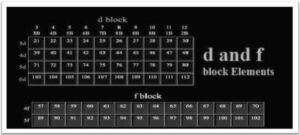Table of Contents
D and F Block Elements: Groups 3 to 12 make up the d-block of the periodic table. The elements in groups 3–12 are known as d-block elements. D-orbitals are gradually filled in these elements as periods increase. The f-block elements have been separated from the rest of the periodic table at the bottom. The f-block consists of elements with successively filled 4 f and 5 f orbitals.
A Brief Outline
Transition elements (or transition metals) are also known as d-block elements, and inner transition elements are known as f-block elements (or inner transition metals). The F block elements are found outside the periodic table at the bottom. The name f-blocks derives from the last electron reaching the f-orbital shell, which is an anti-penultimate shell.
Important Concepts
D-block elements, also known as transition elements, are separated into four groups.
- First Transition Series — The first transition series covers elements in the periodic table’s fourth period, from Sc to Zn.
- Second Transition Series – The second transition series includes elements in the periodic table’s fifth period, ranging from Y to Cd.
- The third transition series includes elements in the periodic table’s 6th period, ranging from Hf to Hg. Lanthanides are also found in the 6th period. Inner transition elements are known as lanthanides.
- Elements in the Fourth Transition Series – Elements in the fourth transition series range from Rf to Cn and are found in the seventh period of the periodic table.
Inner Transition Elements or F-block Elements
Lanthanoids (4f elements; Ce to Lu) and actinoids make up the F-block (5f elements; Th to Lr). The lanthanoid contraction occurs as the atomic and ionic radii fall from lanthanum to lutetium. The actinide series includes all radioactive elements. Electropositive elements are those that have a positive charge. In the air, these metals spontaneously ignite.

Significance of d and f block elements in IIT JEE exam
In the JEE test, the chapter on d and f block elements is worth roughly 8.33 percent of the total 120 marks. The NCERT textbook is used to answer the majority of the questions on this topic. Few queries will undoubtedly be asked about this issue in organic chemistry.
FAQs
Because neither Zn nor Zn+2 ions have partially full d-orbitals, this is the case.
Cu+2 is classified as a transition metal because it has 3d9 incompletely filled d-orbitals.
Zn+2 salts are white because they lack an unpaired electron, whereas Cu+2 salts are coloured due to the presence of an unpaired electron and the d-d transition. Why is zinc not considered a transition metal?
In its ground state, the copper atom possesses entirely filled d-orbitals, yet it is a transition element. Why?
Cu+2 salts are coloured, whereas Zn+2 salts are white. Why?









